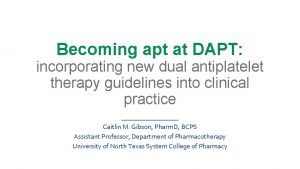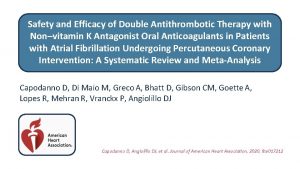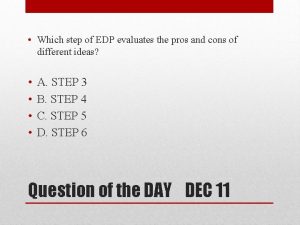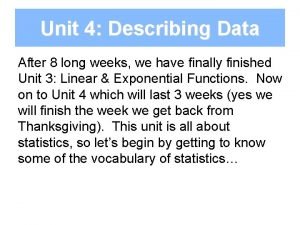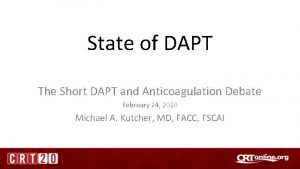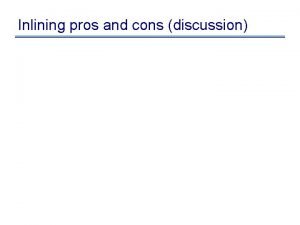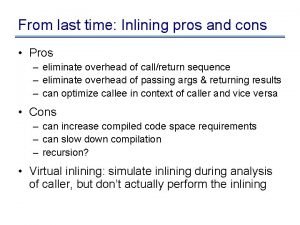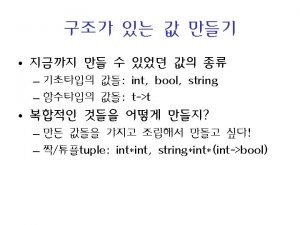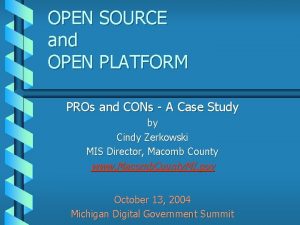Pros and Cons in Implanting of the DAPT





















- Slides: 21

Pros and Cons in Implanting of the DAPT Score Roxana Mehran MD, FACC, FSCAI, FAHA, FESC Professor of Medicine (Cardiology), and Population Health Science and Policy The Icahn School of Medicine at Mount Sinai CRT 2017 20 th Anniversary Washington, DC

Disclosure Statement of Financial Interest Within the past 12 months, I or my spouse/partner have had a financial interest/arrangement or affiliation with the organization(s) listed below. Affiliation/Financial Relationship • Grant/Research Support • Consulting Fees/Honoraria Company • The Medicines Co. , BMS, Astra Zeneca, Lilly/Daiichi Sankyo • Abbott Vascular, Boston Scientific, CSL Behring, Janssen (J+J), Claret • Advisory board for Janssen (J+J), Medscape, Osprey

Outline • Reasons/Rationale for Risk Scores • Risk scores for Duration/Potency of Antiplatelet therapy – is it necessary? • Benefits/Harms of Different DAPT Durations • Correlates of Thrombosis/Bleeding • Current Algorithms • Strengths/Weaknesses • Challenges/Future Directions

What is a Risk Score • General Definition – A tool that quantifies risk and serves as a platform to evaluate the efficacy and toxicity of different therapies – Ideally intuitive, easy to calculate, readily available • Advantages of Risk Scores – Provide empiric, quantitative estimates of risk • Subjective “intuition” is imprecise – Maximize benefits from therapy – identify the “right patient” – Minimize harms – primum non nocere – More efficient allocation of scarce health-care resources

Basis for Risk Scores with DAPT Duration • Principle 1 – More intense platelet inhibition (prolonged exposure or potent therapy) reduces thrombosis • Principle 2 – More intense platelet inhibition (prolonged exposure or potent therapy) increases bleeding • Principle 3 – Magnitude of benefit is counterbalanced by a roughly equal incremental harm nullifying any mortality advantage

Which Event Matters More? Baber U, Dangas G, Mehran R et al. , JACC Int 2016

Correlates of Thrombosis and Bleeding ACS DM Smoking Prior Revasc Older Age CKD Triple Rx Anemia

Current Algorithms

Elements of Clinical Prediction Score and Distribution of Score Among Randomized DAPT Study Patients (Derivation Cohort, 11 648 Patients) The DAPT Score Yeh et al - JAMA. 2016; 315(16): 1735 -1749

DAPT Scores - Multivariable Prediction Models unified into a single integer score to predict clinical benefit Yeh et al – AHA 2015

Continued Thienopyridine vs. Placebo High vs. Low DAPT Score Risk Difference (Continued Thienopyridine – Placebo), 12 -30 M 4. 0% 3. 0% 2. 0% Stent Thrombosis or MI NNT 153 34 P<0. 001 GUSTO Moderate Or Severe Bleed NNH 64 272 P=0. 02 Net Adverse Events NNH NNT 109 37 P<0. 001 1. 55% 0. 92% 1. 0% 0. 37% 0. 0% -1. 0% -0. 66% DAPT Score < 2 -2. 0% -3. 0% -4. 0% DAPT Score ≥ 2 -3. 02% -2. 70% P values are for comparison of risk differences across DAPT Score category (interaction). Yeh et al – AHA 2015

Predicting Risks for Coronary Thrombosis and Major Bleeding After PCI with DES: Risk Scores from PARIS Registry Integer Risk Score for Major Bleeding Parameter Age, years BMI, kg/m 2 Current Smoking Anemia CKD* Triple Therapy on discharge Integer Risk Score for Coronary Thrombosis Score < 50 50 -59 60 -69 70 -79 >80 0 +1 +2 +3 +4 <25 25 -34. 9 > 35 +2 0 +2 Yes No +2 0 Present Absent +3 0 Present Absent +2 0 Yes No +2 0 Parameter Diabetes Mellitus Acute Coronary Syndrome Score None 0 Non-Insulin +1 Insulin +3 No Yes, Tn (-) Yes, Tn (+) 0 +1 Yes +2 No +1 0 Present Absent +2 0 Yes No +2 0 Current Smoking CKD* Prior PCI Prior CABG *Defined as Cr. Cl < 60 m. L/min/1. 73 m 2 Baber U, Mehran R, Giustino G et al – J Am Coll Cardiol. 2016; 67(19): 2224 -2234

Risk/Benefit Trade-off with Prolonged DAPT as a Function of Thrombotic and Bleeding Risk Using the PARIS Score The x-axis displays bleeding risk score. The y-axis displays absolute risk difference in coronary thrombosis and major bleeding at 2 years using the adjusted probability estimates from each respective outcome model. Positive risk differences indicate that a patient’s risk for thrombosis exceeds bleeding whereas negative risk differences indicate the opposite. Each line is fitted to the mean risk difference according to bleeding risk score and ischemic risk category (low, intermediate, or high). Baber U, Mehran R, Giustino G et al – J Am Coll Cardiol. 2016; 67(19): 2224 -2234

Metrics to Evaluate Risk Scores • Discrimination – Does the model assign higher risk estimates to those experiencing versus not experiencing the event? • Calibration – How well do predicted estimates match observed? • Validation – Performance in a separate cohort • Other considerations – Generalizability, ease of use, data quality

DAPT Score Vs. PARIS Score • • Derivation Cohort C-statistic for ischemia = 0. 70 C-statistic for bleeding = 0. 68 Derivation Cohort C-statistic for ischemia = 0. 70 C-statistic for bleeding = 0. 72 Validation Cohort C-statistic for ischemia = 0. 64 C-statistic for bleeding = 0. 64 Validation Cohort C-statistic for ischemia = 0. 65 C-statistic for bleeding = 0. 64 Integer risk score to predict “net clinical benefit” with long- versus short-DAPT beyond 12 months in patients not experiencing ischemic or bleeding events in the first 12 months after stenting Pros Developed in a high-quality and well-conducted RCTs, therefore allowing for direct estimation of treatment effects according to the randomized treatment Simple to use (common clinical variables) App and online calculator available Con Unclear if useful in tailoring “upfront” duration of DAPT post-PCI Most of the included risk factors predict ischemia but not bleeding – may underestimate bleeding risk Unclear if applicable to new-generation DES Modest discrimination • • • gistry Re PARIS Two separate integer risk scores to predict ischemic and bleeding events in real-world patients undergoing PCI. Pros Developed in a real-world population Allows separate estimation of ischemic and bleeding risk Can be applied to tailor “upfront” DAPT Simple to use (common clinical variables) May allow better stratification for bleeding risk Developed in mostly new-generation DES patients Con Does not allow direct estimation of “net clinical benefit” Does not incorporate any anatomical or procedural variable

Strengths/Weakness DAPT Score PARIS Scores RCT Registry Discrimination for bleeding Moderate Discrimination for thrombosis Moderate Calibration Adequate Yes Derivation cohort External Validation

Strengths/Weaknesses con’t • Estimate treatment effect across levels of risk • DAPT >> PARIS • Rigorous follow-up, data quality and control • DAPT >> PARIS • Generalizability • PARIS >> DAPT • Bleeding parameters included • PARIS >> DAPT

Challenges/ Future Directions

Does One Score Fit All? • Anticoagulation in AF – CHADS • Estimate stroke risk • Originally derived in RCT cohorts – HAS-BLED, ATRIA • Estimate bleeding risk • Based on observational or administrative data – Both are complementary to inform decisionmaking

Need for Implementation Barriers to Implementation • Too time consuming • Do not help • Unaware • Not Considered Sposito A et al. , 2009

Conclusions • Risk scores are useful to reliably quantify risk and identify patients most likely to benefit from a given therapy • In absence of any mortality advantage, decision-making surrounding DAPT duration may be enhanced by using prediction tools • Differences in the DAPT and PARIS scores largely reflect the underlying derivation cohorts • Both may serve complementary roles in decision-making, analogous to current approaches for AF • In absence of implementation, however, score development and validation will serve little clinical purpose
 Lydia glaw
Lydia glaw Ticagrelor vs clopidogrel vs prasugrel
Ticagrelor vs clopidogrel vs prasugrel Dapt
Dapt Dapt
Dapt Hub and spoke vs point to point
Hub and spoke vs point to point What is an interpreter
What is an interpreter Pros and cons of byod and cobo
Pros and cons of byod and cobo Pros and cons of series circuits
Pros and cons of series circuits Pros and cons of artificial nutrition and hydration
Pros and cons of artificial nutrition and hydration Objective and task method pros and cons
Objective and task method pros and cons Discusses advantages and disadvantages
Discusses advantages and disadvantages Trebuchet vs catapult pros and cons
Trebuchet vs catapult pros and cons Blackboard pros and cons
Blackboard pros and cons Waldorf education pros and cons
Waldorf education pros and cons Vjfs
Vjfs Vertical farming pros and cons
Vertical farming pros and cons Pros and cons of kinesthetic learning
Pros and cons of kinesthetic learning Histogram vs boxplot pros and cons
Histogram vs boxplot pros and cons Command economy pros
Command economy pros Define thrust stage
Define thrust stage Who governs a dictatorship
Who governs a dictatorship Advantages and disadvantages of unions for employees
Advantages and disadvantages of unions for employees

